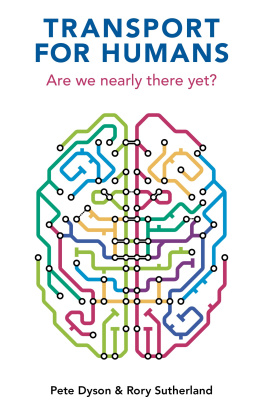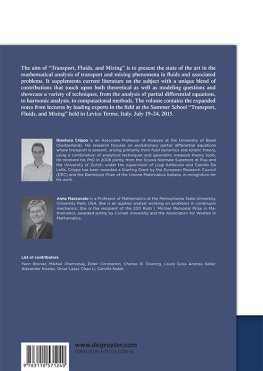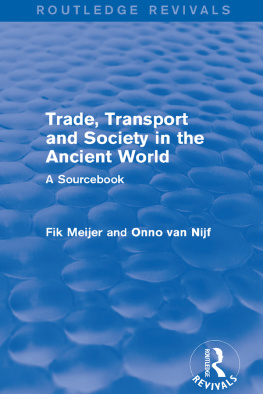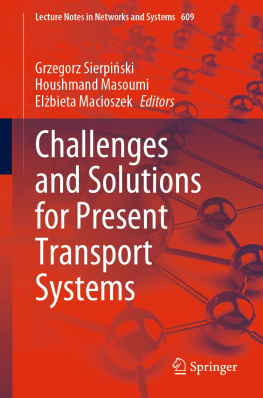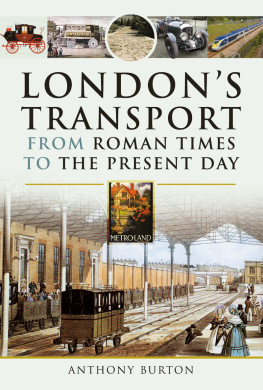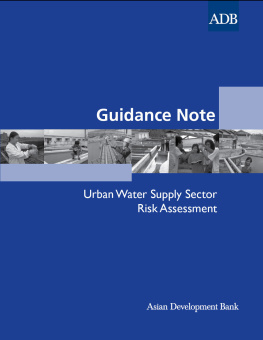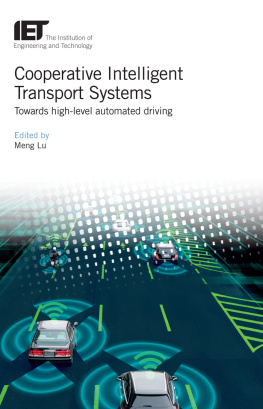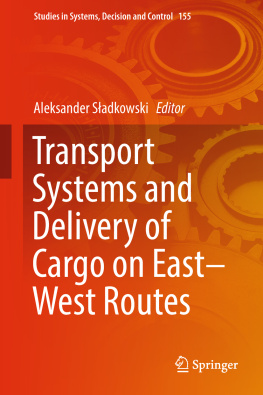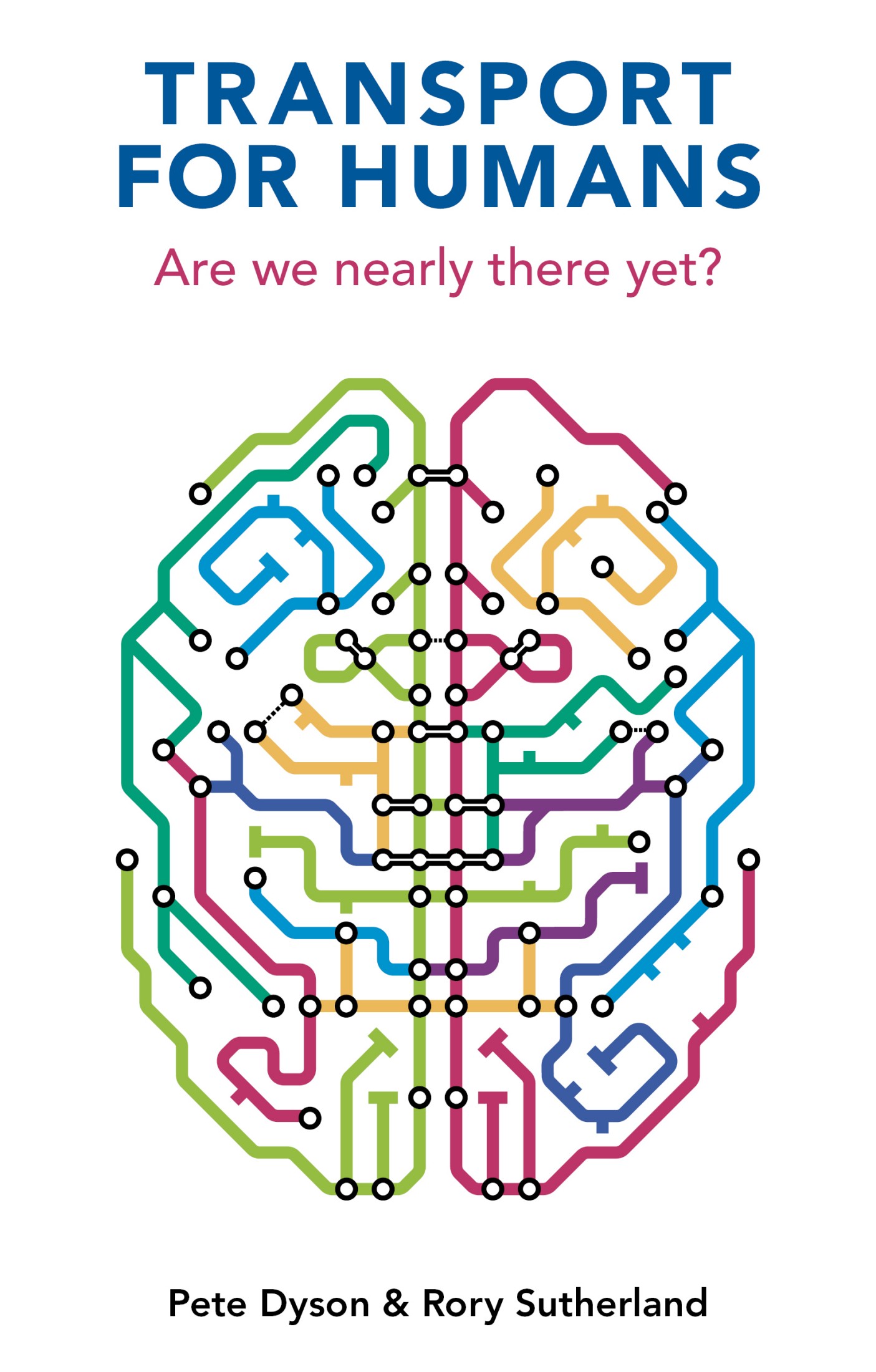Transport for Humans
Series editor: Diane Coyle
The BRIC Road to Growth Jim ONeill
Reinventing London Bridget Rosewell
Rediscovering Growth: After the Crisis Andrew Sentance
Why Fight Poverty? Julia Unwin
Identity Is The New Money David Birch
Housing: Wheres the Plan? Kate Barker
Bad Habits, Hard Choices: Using the Tax
System to Make Us Healthier David Fell
A Better Politics: How Government Can Make
Us Happier Danny Dorling
Are Trams Socialist? Why Britain Has No
Transport Policy Christian Wolmar
Travel Fast or Smart? A Manifesto for an
Intelligent Transport Policy David Metz
Britains Cities, Britains Future Mike Emmerich
Before Babylon, Beyond Bitcoin: From Money That We
Understand To Money That Understands Us David Birch
The Weaponization of Trade: The Great Unbalancing of Politics and Economics Rebecca Harding and Jack Harding
Driverless Cars: On a Road to Nowhere? Christian Wolmar
Digital Transformation at Scale: Why the Strategy Is Delivery Andrew Greenway, Ben Terrett, Mike Bracken and Tom Loosemore
Gaming Trade: WinWin Strategies for the Digital Era
Rebecca Harding and Jack Harding
The Currency Cold War: Cash and Cryptography,
Hash Rates and Hegemony David Birch
Catastrophe and Systemic Change: Learning from the
Grenfell Tower Fire and Other Disasters Gill Kernick
Transport for Humans: Are We Nearly There Yet?
Pete Dyson and Rory Sutherland
Transport for Humans
Are We Nearly There Yet?
Pete Dyson
Rory Sutherland
london publishing partnership 
Copyright 2021 Pete Dyson and Rory Sutherland
Published by London Publishing Partnership
www.londonpublishingpartnership.co.uk
Published in association with
Enlightenment Economics
www.enlightenmenteconomics.com
All Rights Reserved
ISBN: 978-1-913019-35-8 (pbk)
ISBN: 978-1-913019-36-5 (iPDF)
ISBN: 978-1-913019-37-2 (epub)
A catalogue record for this book is
available from the British Library
This book has been composed in Candara
Copy-edited and typeset by
T & T Productions Ltd, London
www.tandtproductions.com
Preface
T his book started from observing simple frustrations with the way we get around. Why are there never enough ticket machines? Why are we stuck in traffic? Are we nearly there yet?
The truth is, we have designed much of the way we live today using an outdated economic model of how humans think, feel and behave. This applies to pensions and political polling just as much as it does to trains, planes and automobiles. When it comes to how we get around, planners have for more than a century rigorously measured speeds and punctuality while missing the unique selling points that make us want to travel or that make the difference between pleasure and frustration or downright fury. Think about your last journey. Did you choose the fastest method, or the most dependable? Did you weigh up every option, or stick to a familiar route? Were you delighted to arrive at your destination feeling fresh, or were you furious and weary? Did a hold-up leave you shuffling hastily along the train platform, hoping a table seat might still await you?
Historically, engineers and accountants have been discouraged from thinking about the human side of their creations and sometimes with good reason. If you are putting a satellite into space or preparing a balance sheet, facts are usually better than feelings. But if you want to engage with people, improve their experience or get them to travel differently, then youll also need insight into the messy world of how people think, feel and behave.
In this book we go far beyond simple frustrations. We make a positive case that adding insights from behavioural sciences can rebalance the current approach to transport. We want to apply the many fascinating insights on why we choose to travel and how we behave when we do. When we understand these forces better, we can improve the job of designing for them or influencing them.
There are plenty of ways we can improve the user experience, but thats only half of it: the experience cannot be considered without wondering about the purpose and the impact of travel. The way people travel is completely intertwined with the dimensions of a good life: equality, sustainability, urban living, remote working and policy goals like levelling up.
Our intended destination should sound familiar to most readers: people being freer to choose public transport when it makes sense, more people able to walk and cycle, less dependency on cars as the only option, adoption of cleaner and greener new technologies, and more investment where it creates more jobs and opportunities. But the route we plot is novel. With dedicated application, behavioural science presents us with a new map to guide transport design. One that takes us along a slightly different path to achieving many of transport policys stated aims (and more besides). To cure a historical obsession with the physical and economic metrics of speed, time and price we advocate applying a more robust, realistic and creative view from a wide range of behavioural and social sciences. That means investing in psychological research, creative idea generation and scientific methods to solve everyday problems that technological innovation and economics cannot solve entirely on their own.
As we write, many of us are travelling less than at any time in our lives, trapped indoors in the middle of the Covid-19 epidemic, and many of us are facing a future in which we will decide more carefully how, and how often, we move about. We are increasingly using videoconferencing and remote-working technologies, such as Zoom and Microsoft Teams, and wondering if we really want to commute in future. Some of us have had those choices made for us. From healthcare workers to posties, millions have continued to travel to work at some personal risk. Transport operators and their staff have gone to considerable lengths to keep countries moving, even adapting train and bus timetables to sync with hospital shift patterns. Decisions are not just financially motivated, they also come from a sense of professional and social duty too. It doesnt feel too much to ask that, if we are going to travel, it should be in comfort, with dignity, and maybe occasionally with joy.
We are inspired by the fact that travellers and transport operators have historically demonstrated a remarkable capacity to innovate and cooperate. We hope that what we are learning now, combined with the insights in this book, will make travel a little more human in future.
Acknowledgements
We are indebted to Diane Coyle for proposing that this book was even a possibility and for having the perseverance to reshape several drafts over its four-year development. Upon her recommendation, brilliant editing by Tim Philips has made the text more precise and much more enjoyable to read. We thank Richard Baggaley and Sam Clark, who have both gone above and beyond with their tenacity to bring the book into existence. Many thanks to Gareth Abbit for originating such an alluring front cover design.
To the team of behavioural scientists at Ogilvy, we hope to have done justice to your high standards of creativity and insight. Particularly gratitude goes to Sam Tatam for his years of guidance, to Daniel Bennett for his down-to-earth smart ideas, and to Anna Cairns for holding us together.
Many thanks to both our families who supported a project that, at times, probably appeared like one too many and especially to Andrew Summers (Petes brother), whose particular skill in constructing a clear line of argument is hopefully spread liberally across the chapters.

